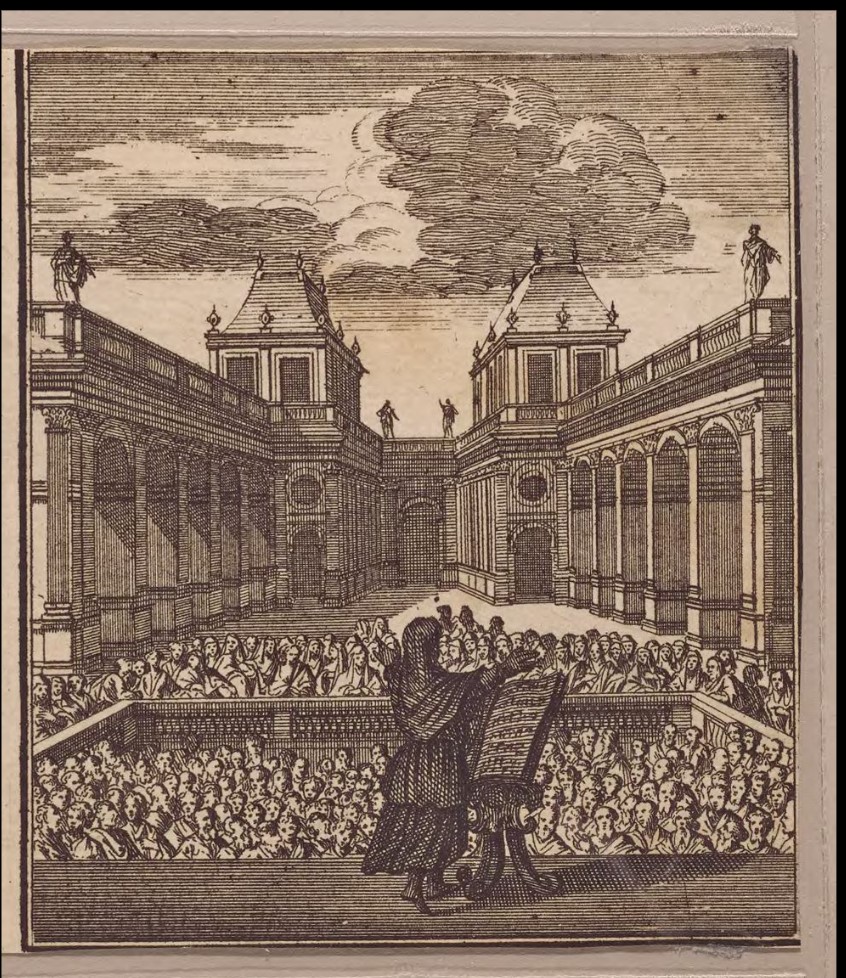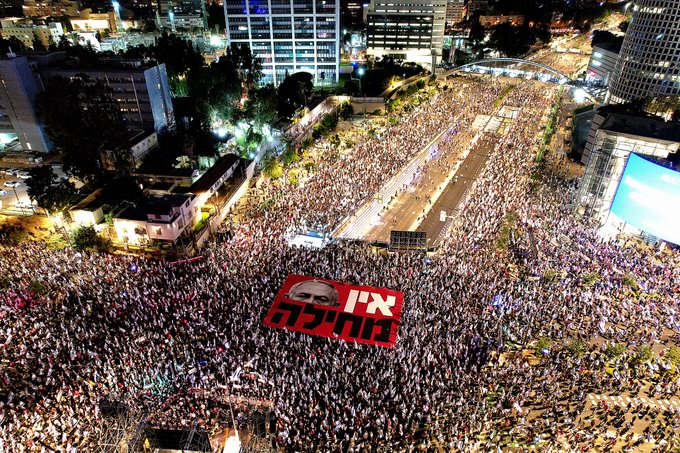Why We Gather

This past motzei Shabbat marked 38 weeks since the demonstrations in Israel against the judicial overhaul began. Once again my social media accounts lit up with photos of the streets of Tel Aviv engulfed in crowds, powerful images of democracy in action. I find the sight of so many people gathering to be awe-inspiring and uplifting, and in a ceremony associated with the holiday of Sukkot, I have found some clues as to why witnessing and joining such gatherings can be so moving.
Just a few weeks ago we read Parashat Vayeilekh, which includes Moses’s command that the Torah be read publicly on Sukkot every seven years:
And Moses instructed them as follows: Every seventh year, the year set for remission, at the Feast of Booths, when all Israel comes to appear before the LORD your God in the place that He will choose, you shall read this Teaching aloud in the presence of all Israel.
Deut. 31:10–11
The ceremony is known by term hakhel (gathering), based on the first word of the verse that follows: “hakhel et ha’am,” “Gather the people—men, women, children, and the strangers in your communities—that they may hear and so learn to revere the LORD your God and to observe faithfully every word of this Teaching” (31:12)
Why does this gathering take place on Sukkot?
According to the biblical scholar Marc Brettler, it is likely that in agriculturally-oriented ancient Israel, Sukkot, not Rosh Hashanah, was the new year festival. Celebrated at the end of the harvest season, it marked the end of one year and the beginning of another. Sukkot was the time when everyone could finally rest after months of hard work. It was thus an appropriate time for this kind of large-scale ritual to take place. And since logistically it would be impossible to gather all members of the community annually, it was instructed to happen once every seven years.[1]
What happens at the Hakhel? The verse says that B’nai Yisrael must gather “so that they may hear, and so learn to revere the LORD your God and to observe faithfully every word of this Teaching” (31:12). Maimonides understands this as a kind of reenactment of the revelation at Sinai (Hilkhot Hagigah 3:6). The only other place in the Tanakh where the phrase “hakhel et ha’am” is used is earlier in Deuteronomy when Moses recounts God commanding him to gather the nation at Sinai.

Print Collection, JTS Library
In this sense, the Hakhel allows future generations to feel the sense of awe and wonder that was present at Sinai. Experiencing the sheer enormity of a gathering where all of Israel would be joined in common purpose would generate a powerful affective response. This sense of awe is furthered by what the Rabbis and commentators understood as the king’s unique role in the ceremony (Sotah 41a). Because the Torah was usually read to the public by the kohen gadol, a prophet or a judge, the king’s presence adds an element of surprise (Abarbanel 31:12).
The integral reason for the Hakhel is that it enables Israel to reconnect with God and renew their relationship with the covenant. Regardless of how powerful the original revelation at Sinai was, we need to be constantly reminded of it. And no one is exempt. According to Maimonides, “Even great Sages who know the entire Torah are obligated to listen with exceedingly great concentration” (Hilkhot Hagigah 3:6). The ritual thus unifies Israel in shared purpose and moral obligation.
The Hakhel is also an occasion to draw attention to the covenant. According to Sefer Hahinukh, when everyone congregates at one time, it inspires people to ask, “What is the reason that everyone is gathering together?” (612). The questions provide an occasion to “praise the Torah and to speak of its value,” to ignite a desire to know God and learn Torah. Gathering can amplify a message by creating a sense of curiosity and wonder.
While we of course do not convene the Hakhel in this way today, many Jewish communities, most prominently Chabad, have creatively thought of ways to revive the concept.[2] Yet there are still other ways we can come together with a sense of shared purpose.

Why do we join public demonstrations? Why does even the sight of large-scale collective action provoke an emotional response? As we learn from our commentators’ views on the Hakhel, it’s because it produces a feeling of awe, of being part of something larger than ourselves, and can create a sense of solidarity without regard for distinctions of age, intelligence, or wealth. It is a moment when instead of feeling powerless to change, we can see that we are not alone in our struggles. We can feel strength and confidence in numbers. And in our “blink and you missed it” world, it allows us to draw attention to the causes and issues that are important in our lives.[3]
As the sociologist and journalist Zeynep Tufekci has written, “Collective action is a life-changing experience. To be in a sea of people demanding positive social change is empowering and exhilarating. Protests work because they sustain movements over the long term as participants bond during collective action.”[4]
I would encourage everyone to consider joining a demonstration, a march, a protest to support any cause about which you feel passionate. It can make you feel more hopeful, more confident, and it can inspire others to keep hoping and working for a better world.
The publication and distribution of the JTS Commentary are made possible by a generous grant from Rita Dee (z”l) and Harold Hassenfeld (z”l).
[1] Marc Zvi Brettler, “The Hakhel Ceremony” (https://www.thetorah.com/article/the-hakhel-ceremony-who-what-when-and-where). There is also a well-known disagreement between the medieval commentators Ibn Ezra and Ramban about whether Hakhel takes place in the seventh year or the eighth year (the year after shemittah).
[2] Jackie Hajdenberg, “The ancient Jewish practice of Hakhel, an every-7-years gathering, gets a 21st century revival,” JTA October 9, 2022.
[3] For a sustained discussion of the Hakhel as a framework for viewing “political gathering as spiritually transformative” see community organizer Meir Lakein’s “On Gathering”. Political Theology, Vol 23. No 1-2 141-147.
[4] “Do Protests Even Work?” The Atlantic. June 24, 2020.



